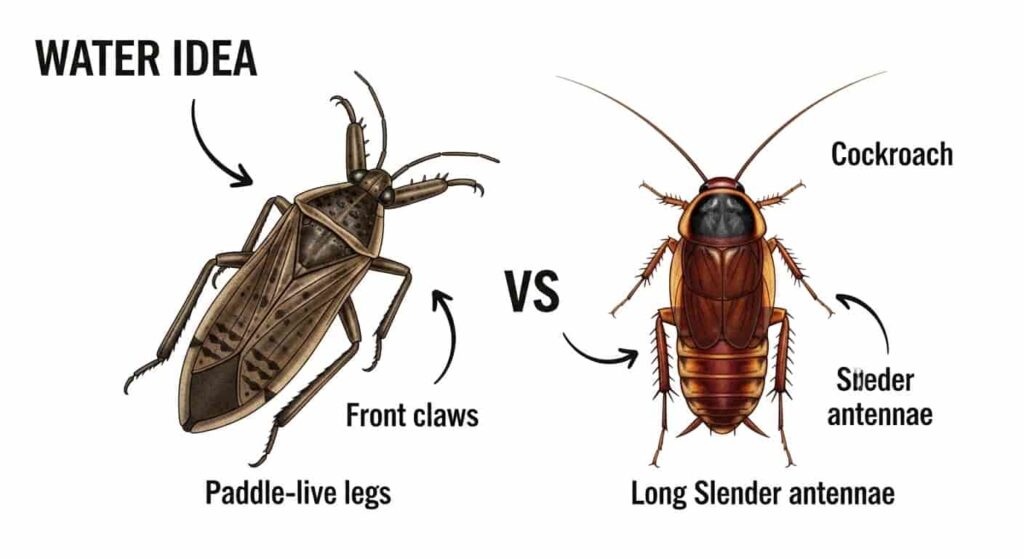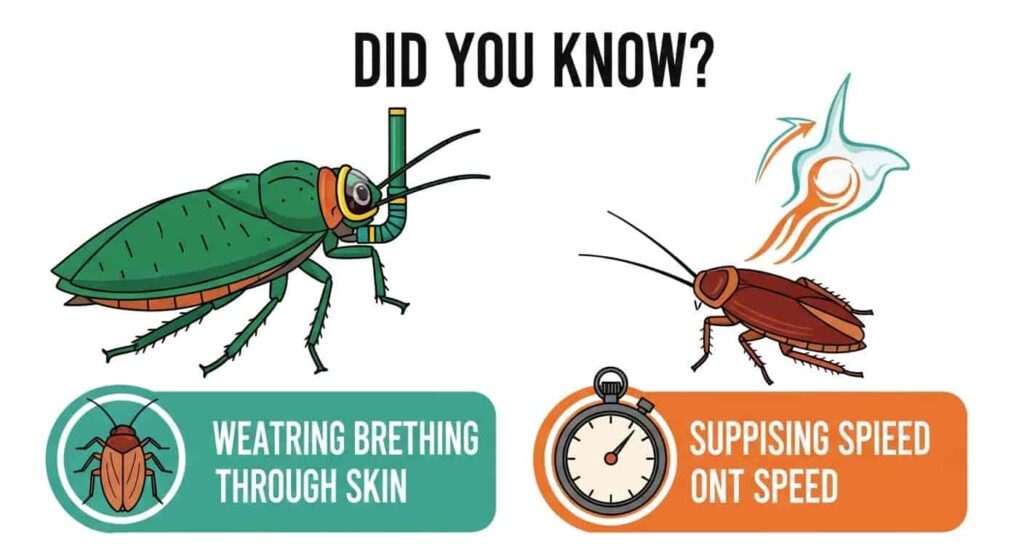Psst! Did you know that not all creepy-crawlies are created equal? That’s right! While water bugs and cockroaches might seem like two peas in a pod when it comes to their bug status, these critters couldn’t be more different. Picture this: one loves the water and is a skilled swimmer, while the other thrives in the shadows of your kitchen, creeping around at night. Understanding the water bug vs cockroach differences is not just a fun fact . it’s essential for homeowners and pest control enthusiasts alike!
So why should you care? Well, knowing the distinctions between these two insects can help you tackle pest problems more effectively and even appreciate their unique roles in nature. Whether you’re an entomology student eager to impress your classmates or a curious nature lover wanting to expand your bug knowledge, this article will dive into the nitty-gritty details. From their physical characteristics to their ecological roles, we’ll explore everything you didn’t know about water bugs and cockroaches. Trust us; it’s worth sticking around for! Let’s get started!
Physical Characteristics
Let’s dive into the nitty-gritty of what makes water bugs and cockroaches so distinct. First up, water bugs, or as they fancy themselves, “giant water beetles,” flaunt a flat and oval body, usually measuring between 1 to 4 inches long. They have long, paddle-like legs that make them the Michael Phelps of the insect world — quick in the water! Their coloration can range from a dark brown to a greenish hue, giving them that slick, aquatic vibe. And don’t forget those formidable front claws; they’re not just for show! These guys are fierce predators, using those claws to snag smaller prey like tadpoles and fish.
Now, let’s turn our attention to cockroaches. You may know these little critters best for their knack for sneaking around your kitchen at night. Cockroaches come in various sizes, typically around 1 to 3 inches long, with some species (like the American cockroach) strutting their stuff at a whopping 4 inches! Their bodies are oval and somewhat flattened, but what really sets them apart is their long, slender antennae that can be even longer than their bodies! As for colors, think shades of brown to black, often with a shiny finish that makes them look like they just stepped off a runway — if only runway models scuttled through your pantry!
When comparing water bug vs cockroach differences, it’s essential to note that while both insects exhibit some similar traits — like their ability to blend into their environments — they’re tailored for entirely different lifestyles. Water bugs thrive in aquatic settings, showcasing adaptations like those paddle-like legs, whereas cockroaches prefer terrestrial habitats and are masters of hiding in crevices and cracks. So, if you ever find yourself pondering these insect differences while enjoying a day by the pond or battling a pest control issue in your home, remember that each creature has its own remarkable set of features designed for survival!

Habitat Preferences
When it comes to habitat preferences, water bugs and cockroaches are like night and day, each finding their cozy spots in the world. Water bugs, or “toe-biters” as they’re sometimes called (yikes!), thrive in freshwater environments. You’ll often find them lurking in ponds, lakes, and marshes, where they can do their thing — swimming around and hunting for tasty snacks like tadpoles and small fish. They prefer slow-moving waters with plenty of vegetation to hide in, making them the perfect little predators of the aquatic ecosystem. So, if you’re near a calm body of water and notice some movement beneath the surface, keep an eye out — those could be water bugs making waves!
On the flip side, cockroaches are true urban survivors. These little critters are experts at finding shelter in the most unexpected places. From your kitchen cabinets to basements and even sewers, cockroaches love dark, damp environments where they can scuttle around undetected. They thrive in human-made habitats because, let’s face it, we provide a buffet of food options for them! Their adaptability to various living conditions allows them to flourish in both rural and urban settings, showcasing their resilience as they navigate through our daily lives.
The differences in habitat also influence their behaviors. Water bugs are typically more solitary hunters, using their stealth and speed to ambush prey in water. They possess a unique ability to hold their breath for extended periods, which aids in their hunting tactics. On the other hand, cockroaches tend to be social creatures that prefer to roam in groups when foraging for food. Their nocturnal habits mean they’re most active when the lights go out, making a midnight snack run through your pantry a common occurrence. This social behavior helps them thrive in environments where they can easily communicate and share resources.
Understanding these habitat preferences not only highlights their distinct roles in our ecosystems but also sheds light on how our interactions with these insects can differ. While water bugs may occasionally cross paths with humans (and give us quite a scare!), cockroaches are often viewed as pesky intruders that require pest control measures. So, whether you’re enjoying a peaceful day by the lake or battling an infestation in your home, knowing where these critters call home can make all the difference!

Behavior and Activity Patterns
When it comes to the behavior and activity patterns of water bugs versus cockroaches, the differences can be as stark as night and day. Water bugs, also known as “toe-biters,” are fierce predators in their aquatic habitats. They hunt by stealthily gliding through the water, using their elongated bodies and strong legs to pounce on unsuspecting prey like tadpoles or even small fish. Their feeding habits are quite impressive; they use their piercing mouthparts to inject enzymes that liquefy their meals, making it easier to slurp them up. Talk about a dinner party with a twist!
On the flip side, we have our good ‘ol cockroaches, which are notorious for their nocturnal antics. These little critters prefer to party when the sun goes down, making them more active during the night. If you’ve ever flipped on a light in your kitchen only to see them scurry away, you’ve witnessed their famous flight response firsthand! Cockroaches tend to be social insects, often found in groups as they share resources and communicate through pheromones. However, unlike water bugs, they aren’t exactly hunting for dinner; rather, they’re foraging for scraps and leftovers — making them more of a nuisance than a predator.
Now, let’s address some common misconceptions: many people think all insects are solitary creatures. While it’s true that water bugs often operate alone when hunting, cockroaches thrive in communities. This social behavior is key to their survival, as it allows them to navigate threats and find food more efficiently. So, if you’re trying to identify insects around your home, remember that the presence of multiple cockroaches likely signals an infestation, while spotting a lone water bug near your pool could just mean it got a bit lost on its quest for dinner.
In summary, understanding the behavior and activity patterns of these two insects is crucial not only for pest control enthusiasts but also for anyone curious about nature’s intricacies. Whether it’s the fierce hunting skills of water bugs or the nocturnal escapades of cockroaches, the differences between these two critters are fascinating — and knowing them can help you tackle any insect encounter with confidence!

Ecological Roles
Psst! Did you know that both water bugs and cockroaches play vital roles in their respective ecosystems? Let’s dive into the fascinating world of these insects and uncover how they contribute to the balance of nature. Starting with our aquatic friends, water bugs are not just creepy crawlies lurking in ponds; they are essential players in aquatic ecosystems. As predators, they help keep populations of smaller insects and even tadpoles in check. Their hunting prowess allows them to maintain a healthy balance, ensuring that the food web remains intact. Plus, they serve as a food source for larger animals, like fish and birds, making them key players in the circle of life!
On the flip side, cockroaches might not win any popularity contests, but they have their own important role in terrestrial ecosystems. These resilient little critters are nature’s recyclers, breaking down organic matter like dead leaves and decaying plants. This process enriches the soil, promoting healthy plant growth and contributing to the overall health of natural habitats. It might be hard to appreciate them when they scuttle across your kitchen floor, but without them, our ecosystems would struggle to thrive.
Now, let’s talk about interactions! Both water bugs and cockroaches interact with various species in ways that might surprise you. For instance, water bugs can be found sharing their watery homes with frogs and fish, forming a unique relationship where each benefits from the presence of the other. Meanwhile, cockroaches often hang out with microorganisms that help break down waste materials. Talk about teamwork! These interactions highlight the intricate web of life where every creature has its place — no matter how small or seemingly insignificant.
In essence, while water bugs and cockroaches may seem like two peas in a pod when it comes to being misunderstood, they are far from interchangeable. Each insect plays a crucial role in maintaining ecological balance within their environments. So next time you come across one of these critters, take a moment to appreciate their contributions to our world!
Human Interaction and Impact
When it comes to human interaction, water bugs and cockroaches take very different paths. Water bugs, for instance, are usually more of a “surprise guest” at the pool party or the backyard pond rather than the uninvited roommate. They thrive in aquatic environments, and while they might occasionally wander into your home, it’s not often you’ll find one lounging on your kitchen counter. When they do show up, it’s usually a result of a sudden flood or a push from their natural habitat. So, if you happen to spot one making a splash in your living room, just remember: it’s probably as confused about its surroundings as you are!
On the flip side, cockroaches are notorious for being the party crashers of the insect world — and let’s be real, nobody wants these guys showing up uninvited! These little critters have developed a reputation for being pests, primarily due to their uncanny ability to invade homes and cause health concerns. Cockroaches can carry bacteria and allergens that may pose risks to humans, especially in kitchens and places where food is prepared. So if you ever find yourself asking, “What’s the difference between water bugs and cockroaches?” just remember that while water bugs might be an occasional nuisance, cockroaches are often the ones you need to worry about when it comes to your health.
Culturally speaking, both insects have their own unique reputations. Water bugs are often portrayed in literature and media as mysterious creatures of the night, evoking curiosity rather than fear. In contrast, cockroaches have become symbols of resilience and survival — after all, they can withstand some serious conditions! From horror movies to urban legends, cockroaches have secured their place in our collective consciousness as unwelcome guests. This perception can lead to a skewed understanding of both insects, overshadowing the fascinating roles they play in our ecosystems.
So next time you find yourself pondering the water bug vs cockroach differences explained, think about how our interactions with them shape our views. Whether it’s a fleeting encounter with a water bug or a persistent battle against cockroaches, each experience adds to the story of how we coexist (or don’t!) with these incredible yet misunderstood creatures. Embracing their uniqueness might just help us appreciate the diversity of life buzzing around us!
Pest Control Considerations
When it comes to tackling a cockroach infestation, the stakes can feel high! These little critters are not just unsightly; they can pose health risks too. If you find yourself in a battle against cockroaches, start by ensuring your home is clean and free of food sources. Make it rain with some good ol’ soap and water to scrub down surfaces, and don’t forget to vacuum those nooks and crannies where crumbs tend to hide. For a more proactive approach, consider using bait stations or gels that contain insect growth regulators – they’ll help disrupt the roaches’ life cycle. Just remember to place them strategically in areas where you’ve spotted these pesky bugs!
Now, let’s talk about water bugs. While they’re generally less of a nuisance than cockroaches, an unexpected encounter can still send you into a mini panic! To deal with water bugs, it’s crucial to address their preferred habitats. These critters thrive in damp areas, so check your home for any leaks or standing water. Fixing those leaks can be as simple as tightening a faucet or checking under the sink. If you happen to spot a water bug indoors, don’t reach for the nearest shoe – instead, try trapping it under a glass and sliding a piece of paper underneath. Then, release it outside, far from your home. Who knew pest control could feel like a mini science experiment?
Prevention is key for both cockroaches and water bugs, my friends! Regular maintenance can save you from future infestations and keep your home feeling fresh. Seal up cracks and gaps around windows and doors; think of it as giving your home a cozy blanket. Keep your kitchen tidy by storing food in airtight containers and taking out the trash regularly. And if you live near bodies of water, like lakes or rivers, ensure your yard is free from standing water – it’s like rolling out the welcome mat for those water bugs!
In summary, whether you’re dealing with cockroaches or water bugs, understanding their behaviors and habitats is essential for effective pest control. With a little effort and some preventive measures, you can keep your home bug-free and enjoy peace of mind. So grab those cleaning supplies and get to work – your future self will thank you!
Lesser-Known Facts
Psst! Did you know that water bugs can actually breathe through their skin? That’s right! These fascinating little critters, also known as “toe biters,” have a unique adaptation that allows them to extract oxygen from the water around them. They’re like the underwater ninjas of the insect world, stealthily lurking in ponds and streams. On top of that, some species can even deliver a painful bite if they feel threatened. So, while they might look like oversized roaches, the water bug vs cockroach differences explained go way beyond just their habitats and appearances!
Now, let’s dive into the world of cockroaches. One surprising truth is that these resilient creatures can survive without food for up to a month! But don’t get too comfortable with the idea of having them around; they can only live about a week without water. Also, here’s a fun fact: cockroaches are super fast – they can scuttle away at speeds of up to 3 miles per hour! Talk about a speedy getaway! Their ability to adapt and thrive in various environments is what makes them such notorious pests in our homes.
But wait, there’s more! Let’s debunk some common myths about both insects. Many people believe that all cockroaches are dirty and spread disease, but not all species are harmful. In fact, some play vital roles in breaking down organic matter in nature. Similarly, there’s a misconception that water bugs are dangerous to humans; while their bites can be painful, they’re generally not aggressive towards us unless provoked. By understanding these water bug vs cockroach differences explained in detail, we can appreciate these insects for their roles in our ecosystems rather than simply viewing them as pests.
So, whether you’re a pest control enthusiast or just a curious nature lover, these lesser-known facts serve to highlight the intriguing lives of water bugs and cockroaches. Next time you spot one of these critters, remember that they’re not just annoying intruders but complex organisms with unique adaptations and ecological roles!

Wrapping It Up: Water Bug vs Cockroach Differences Explained
So there you have it, folks! We’ve journeyed through the fascinating world of water bugs and cockroaches, uncovering their key differences along the way. From their distinct physical traits and habitat preferences to their unique behaviors and roles in our ecosystems, it’s clear that both of these insects play vital parts in nature’s grand design. While water bugs may glide gracefully through the water, cockroaches are busy keeping things interesting on land — each with their own quirks that make them special.
As you go about your day-to-day life, remember to appreciate the little critters that share our environment. Whether you’re a homeowner looking to keep pests at bay or a curious nature lover, understanding these “bugs” can enhance your perspective on the world around you. So next time you spot a water bug or a cockroach (or hear someone say “eww!” about them), take a moment to celebrate their uniqueness — because there’s a whole lot more to them than meets the eye!
FAQ Water Bug vs Cockroach Differences
What are the main physical differences between water bugs and cockroaches?
Water bugs are generally larger, with a more elongated, flattened body and long legs adapted for swimming. Cockroaches have a more oval-shaped body and shorter legs.
Do water bugs and cockroaches belong to the same family?
No, water bugs belong to the family Belostomatidae, while cockroaches are part of the Blattidae family, making them distinct groups within the insect kingdom.
Where are water bugs typically found compared to cockroaches?
Water bugs are primarily aquatic and found in freshwater environments like ponds and streams. Cockroaches are terrestrial and often inhabit warm, dark areas in homes and buildings.
Are water bugs dangerous to humans like some cockroaches?
While water bugs can deliver a painful bite if provoked, they do not pose the same health risks as cockroaches, which can spread disease and trigger allergies.
How do water bugs and cockroaches reproduce?
Water bugs lay their eggs in water, often attaching them to vegetation, while cockroaches typically lay their eggs in protective cases called oothecae in hidden areas.
Can both water bugs and cockroaches fly?
Cockroaches are capable of flight, though not all species do so regularly. Water bugs can also fly, particularly when seeking new habitats or mates.
What do water bugs eat compared to cockroaches?
Water bugs are predatory and feed on other aquatic creatures, while cockroaches are omnivorous scavengers that consume a wide range of organic matter.
How can I tell if I have a water bug or a cockroach infestation in my home?
Look for the habitat signs: water bugs will be near moisture sources like sinks or bathtubs, while cockroach droppings and shed skins will be found in dark, warm places like kitchens or basements.





